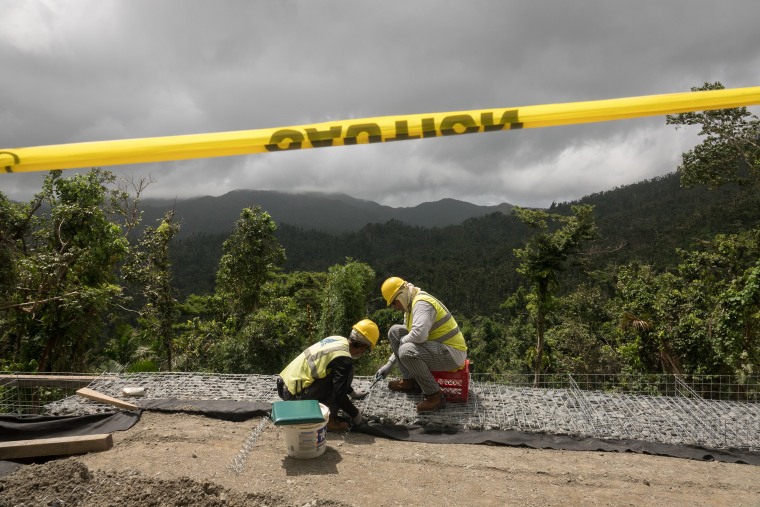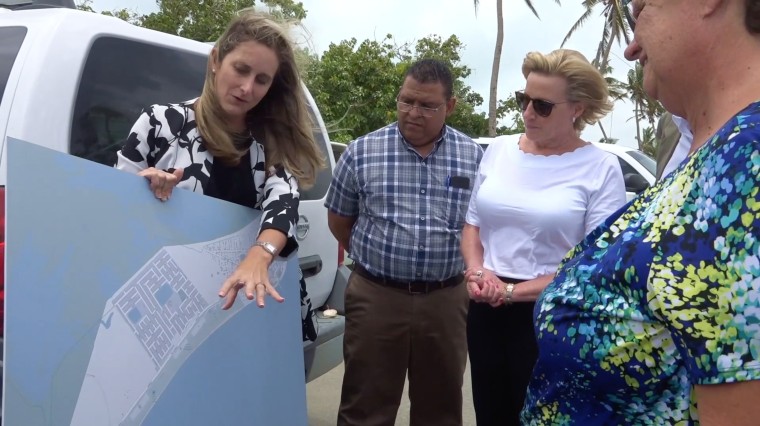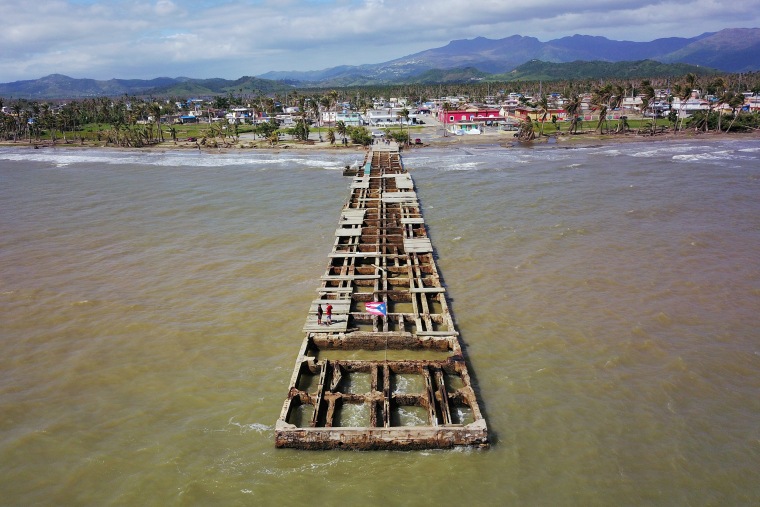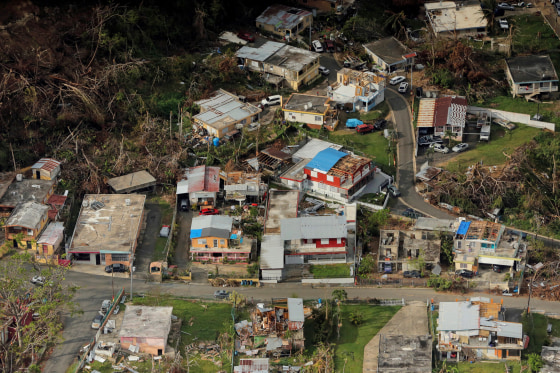SAN JUAN, Puerto Rico — Ramón Otero has worked toward improving his community of Parcelas Nuevas after Hurricane Maria left it almost unrecognizable nearly a year and a half ago.
“Roads still in poor conditions need to be rebuilt … some homes in communities like Jájome still have blue tarps,” Otero told NBC News in Spanish. “Almost all of Puerto Rico still has sectors that lack proper lighting.”
But 2019 has emerged as a year of new possibilities for an island grappling with the deadliest natural disaster in the United States in a century, which killed at least 2,975 people.
In the town of Cayey, community leaders such as Otero have been doing their part: helping families whose homes were deemed uninhabitable find new places to live, and identifying people who were denied federal aid last year to fix their hurricane-ravaged homes.

Gov. Ricardo Rosselló promised that “2019 will be the year in which we build a new Puerto Rico.”
“We find ourselves in a frank recovery process in order to rebuild our island in a way that’s well planned, that maximizes its potential,” he said in his end of year statement in December 2018.
To fulfill such promise amid economic and political turmoil, officials need to find ways to secure the disbursement of critical federal housing funds, spend them appropriately to effectively rebuild the island’s infrastructure and tackle issues such as informal or illegal construction and the increasing number of vacant properties.
When will people in the island see the assigned funds?
Progress in Puerto Rico has been relatively stalled since only a small fraction of the federally approved funds has been disbursed.
Congress appropriated at least $136.1 billion in disaster relief funds, according to an analysis from the Center for Puerto Rican Studies. While the money goes to an array of local and federal agencies, the Federal Emergency Management Agency and the Department of Housing and Urban Development are two of the most crucial agencies in the recovery process.
The federal government has disbursed more than $3.7 billion for FEMA to finance local government grants to complete debris removal, public infrastructure repairs and give direct aid to affected individuals, according to numbers provided by FEMA spokesman Juan A. Rosado-Reynés.
On Feb. 2, Rosselló announced HUD authorized the disbursement of the first $1.5 billion of a total of $20 billion granted through the agency’s Community Development Block Grant-Disaster Recovery Program for infrastructure repairs and rebuilding homes. Puerto Rico originally expected to receive part of this money in January, but the longest government shutdown in U.S. history delayed the process. Some of the CDBG-DR funds are set to finance 28 programs in Puerto Rico, some similar to the one Annie Mayol runs.

Mayol is the president and chief operating officer at the Foundation for Puerto Rico, a not-for-profit organization based in the U.S territory that seeks to promote opportunities for social and economic development with the help of a network of smaller community groups. She recently partnered with Puerto Rico’s Housing Department to create the first community-focused reconstruction program set to be funded with $37.5 million in CDBG-DR funds.
“We think about resiliency in a more holistic way, that our communities have the resources to plan their own communities better," Mayol told NBC News.
Foundation for Puerto Rico would invest almost $500,000 per community to help them identify the main issues — whether they are in the areas of housing, infrastructure, access to health services or economic development — and eventually provide the resources necessary for sustainable solutions.
The program’s first phase consists of field work and data research that could help communities identify risks.
“These bottom-up efforts are key for long-term sustainable growth,” Mayol said.

A decade long recession has left Puerto Rico unable to fund reconstruction projects on its own.
However, fulfilling these efforts are under threat since President Donald Trump has threatened to cut funding for Puerto Rico in multiple occasions.
On Jan. 16, the Trump administration publicly opposed to Puerto Rico receiving $600 million for its nutrition assistance program, calling it “excessive and unnecessary.”
Reports that Trump could use $2.5 billion set aside to finance reconstruction projects in the island to pay for a U.S.-Mexico border wall surfaced earlier this year.
“That is against the law," Puerto Rico Housing Secretary Fernando Gil Enseñat told NBC News. “The funds were destined for [housing in] Puerto Rico.”
Also, local officials point out that a federally-appointed oversight board monitors every single economic decision made by the island’s government.
Rosselló said his administration would consider suing Trump if he redirects recovery funds to finance a border wall.
Fighting Trump's accusations that Puerto Rican politicians are trying to use the recovery money "to pay off other obligations” could lead to a conflict that might affect the disbursement of federally assigned funds in unpredictable ways.
“Without an element of [economic] sustainability, any kind of infrastructure I put up won’t be sustainable,” Gil Enseñat said.
Although Puerto Rico has every right to receive already-assigned federal funds, economic sustainability to finance long-term reconstruction efforts “is not just [bound to] federal money," said Mayol, who also emphasized that the private sector, philanthropic and other nongovernmental organizations have a role in securing Puerto Rico’s financial future and help the island diversify its income streams.
Proving homeownership
Gil Enseñat said he wants to be able to replicate Mayol's community program in hundreds of neighborhoods across Puerto Rico. He also believes that the issue around lack of property titles is worth tackling promptly.
This first became a problem for residents when they tried to access FEMA’s individual aid program to repair their homes after the hurricane.
At least 533,000 people, more than half of all applicants, were denied or deemed ineligible to access such program, according to FEMA numbers. Lacking property titles to prove home ownership under FEMA’s standards was one of the main reasons why so many didn’t get the help they requested.
Puerto Rico plans to implement a $40 million program to provide property titles to some of those who did not receive aid. For Gil Enseñat, providing this documentation also opens a pathway for the local government to better collect revenues through property taxes and enforce legal construction in the island.
The number of denied FEMA applications also highlights a bigger issue that has confronted the island for decades and was exacerbated by the hurricane — a history of informal housing development and illegal construction.
Though there are no official government figures, conservative estimates suggest that around 260,000 houses in Puerto Rico were built without the appropriate legal documentation and permits, according to David Carrasquillo, president of the Puerto Rican Planning Society, a private entity that brings together urban development experts.
Previous estimates from the Puerto Rico Builders Association, an industry group, suggest that about 55 percent of the island’s infrastructure — more than half — was informally built, including 700,000 houses and commercial buildings. This practice led many Puerto Rican families to pass down properties generation after generation without having a proper property deed.
But providing property titles to these residents won't fully solve the issue, Carrasquillo told NBC News. Other options should exist for residents to prove homeownership and legally access federal housing aid moving forward.
He said organizations such as Ayuda Legal Puerto Rico, a nonprofit that provides legal support to low-income communities, are proposing using a "uniform document" as an alternative to having a property deed.
"The federal legislation is clear: a person does not need to have a [property] title to access funds to repair their homes after a disaster,” Ayuda Legal said in a statement.
So far, Puerto Rico's Housing Department has not responded to Ayuda Legal's proposal.
Advocates have also raised concerns over expropriation risks that could disproportionately fuel displacement among residents of informal communities, even if property titles are granted to them.
Laws in Puerto Rico allow the local government to take over private properties for public use in exchange for payment or compensation. But the definition of public use is so broad that the Institute for Justice, a nonprofit that monitors expropriation abuse, pointed out in a report that “municipalities can take (and have taken) property for anything they deem a public purpose — including shopping malls, restaurants and luxury housing developments.”
Why not use vacant housing?
For Carrasquillo, "the exorbitant amount of abandoned spaces” is the most pressing housing issue in Puerto Rico.
According to a report from the Center for Puerto Rican Studies, “the excess supply of vacant homes in Puerto Rico is a clear impediment to economic recovery.”
The number of vacant homes in Puerto Rico has been increasing since 2006. By 2016, 18 percent of the island’s housing stock was vacant and a spike in foreclosures after the hurricane suggests that vacant units are increasing at an accelerated rate.
Authors of the report issued two recommendations. One is to turn vacant government-owned buildings, such as closed schools, into social purpose housing. Another is to implement a housing program that converts vacant units into affordable housing facilities “to mitigate the endemic challenge of widespread informal housing not built to [legal construction] code.”
“But right now we’re going in the opposite direction,” Carrasquillo said.
Vacant properties are only addressed once in the action plan from Puerto Rico’s Department of Housing, which outlines how the government plans to use HUD funds. It says that the vacant units “will be a primary line of action” to relocate residents who live in flood zones or areas deemed dangerous.
FOLLOW NBC LATINO ON FACEBOOK, TWITTER AND INSTAGRAM.



